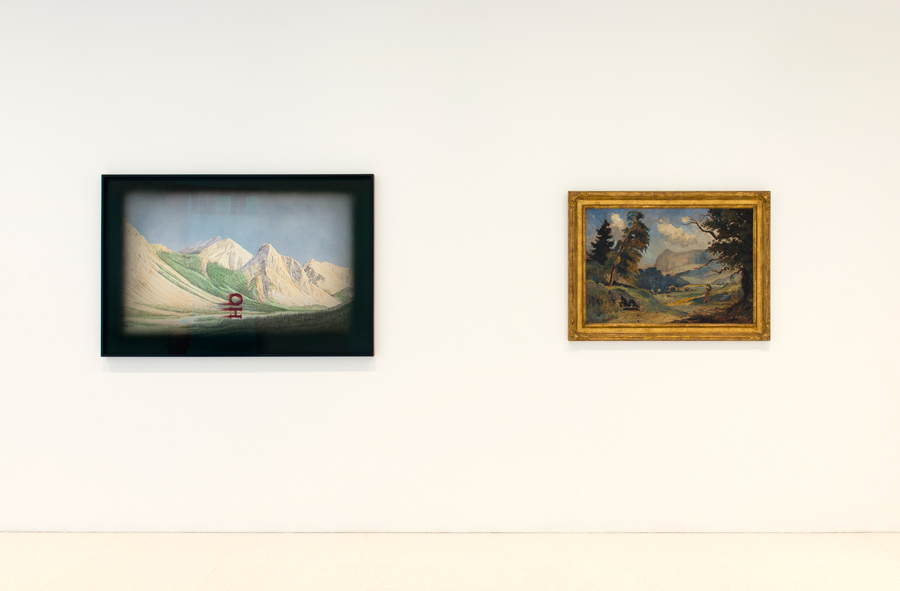What did Ed Ruscha Learn from Eilshemius?
A show at Gagosian, London, pairs the pop master with the early twentieth-century eccentric, beloved of Duchamp
A show at Gagosian, London, pairs the pop master with the early twentieth-century eccentric, beloved of Duchamp

The front of Louis Michel Eilshemius’s business card identified him as an ‘amateur all round doctor, mesmerist-prophet and mystic reader of hands and faces, linguist of 5 languages, graphologist, dramatist (7 works), short story writer and novelettes (26 works), humorist galore, ex-mimic, animal voices’, amongst sundry other professions. (Note: he was also a painter.) On the reverse was an 8-point list titled ‘A few Inventions and Discoveries’, the first of which read: ‘How to paint wonderful frames around his paintings in gold, mahogany, any material (1911)’. While the idea of Eilshemius mimicking animals is certainly charming, it is in this latter declaration that I have more faith.
At Gagosian’s Davies Street space, the frames are wonderful indeed. Dreaming of Temptation (1919), a positively Blakean scene in which the sanctity of a nude woman’s bedchamber is threatened by a looming spirit, is fixed within a primary boundary of painted ochre and a secondary frame of ornate wood. Landscape with Waterfall (c.1910–13) is contained within a painted frame of metallic gold and black, whose cartoonish trompe l’oeil curves position the bucolic vista as a parodic romantic landscape. Untitled (c.1909–13) is a tiny dusk-time pastoral. It is held within 1) a rounded border of golden oil 2) an unassuming wooden frame 3) a mauve canvas 4) a final wooden frame, its edges worn and dolorous. Frames within frames within frames: a painterly nesting doll; a formalist joke at our expense.

Eilshemius, who died in 1941, is often referred to as an ‘artist’s artist’. While he struggled to establish himself during his lifetime, he was famously ‘discovered’ by Duchamp, who happened upon his work in 1917 and, in 1920, co-organized his first (and last) major exhibition, at Société Anonyme. As such, Eilshemius has been posthumously deified, elevated to that near-mythic status reserved for those neglected during their lifetime (including those of ‘unbalanced mind’, as Clement Greenberg irresponsibly described him in 1946). Unsurprisingly, perhaps, given the artistic lust for the ‘authentic’, his work subsequently found its way into the collections of Louise Bourgeois, Jeff Koons and Ugo Rondinone.

Another admirer is Ed Ruscha, from whose collection the works at Gagosian are taken, and whose characteristically cinematic series ‘Spied Upon Scene’ (2017–18) embraces the motif of the faux-frame. Interspersed within Eilshemius’s paintings, the series depicts heroic mountain ranges, each of which looms in front of burnt sky and is viewed through either a window or vignette effect. At times, the paintings threaten to intrigue – take the carmine lettering that scrapes across Spied Upon Scene: Oh/Ho (2017). But, more often, they look like less interesting versions of Ruscha’s ‘Mountain Paintings’ (begun in 1997), which overlaid the majesty of the 19th-century sublime with the vocabulary of suburban monotony in a manner both deadpan funny and deathly poetic. You could argue that the dull emptiness of this recent series is deliberate – a nod to the way in which beauty is mediated – but you would emerge red-faced.

A frame is window and wall at once; it marshals what we do and, crucially, do not see. In this, it is a structure of control: a regulatory architecture deployed in order to establish sovereignty over our gaze. It was for this reason, perhaps, that Henri Matisse described the four sides of a frame as ‘the most important parts of a picture’, and for this reason, also, that Eilshemius and Ruscha shuffle the structural components of their paintings back into view. For it is the frame that closes a scene and declares a fragment a whole, which professes the significance of Ruscha’s otherwise insignificant mountains. But, as Eilshemius’s formal experimentation implies, that which proclaims authority does not necessarily deserve it: frames can always be repeated, rethought or disregarded altogether.
Main image: Edward Ruscha, Spied Upon Scene, 2017, acrylic on museum board paper, 1 × 1.5 m. Courtesy: © the artist and Gagosian; photograph: Jeff McLane
























